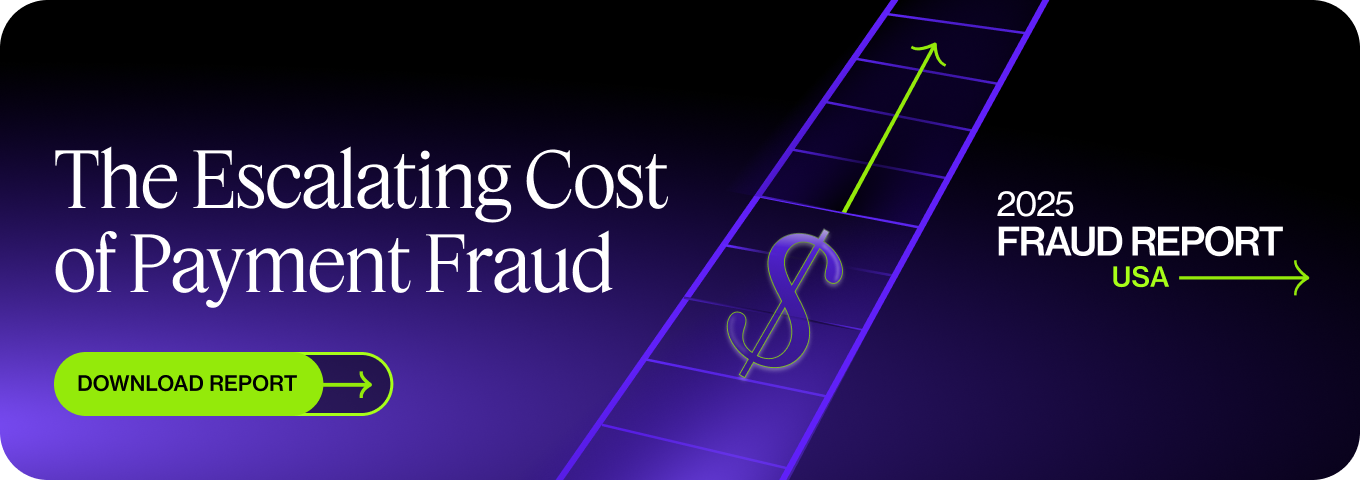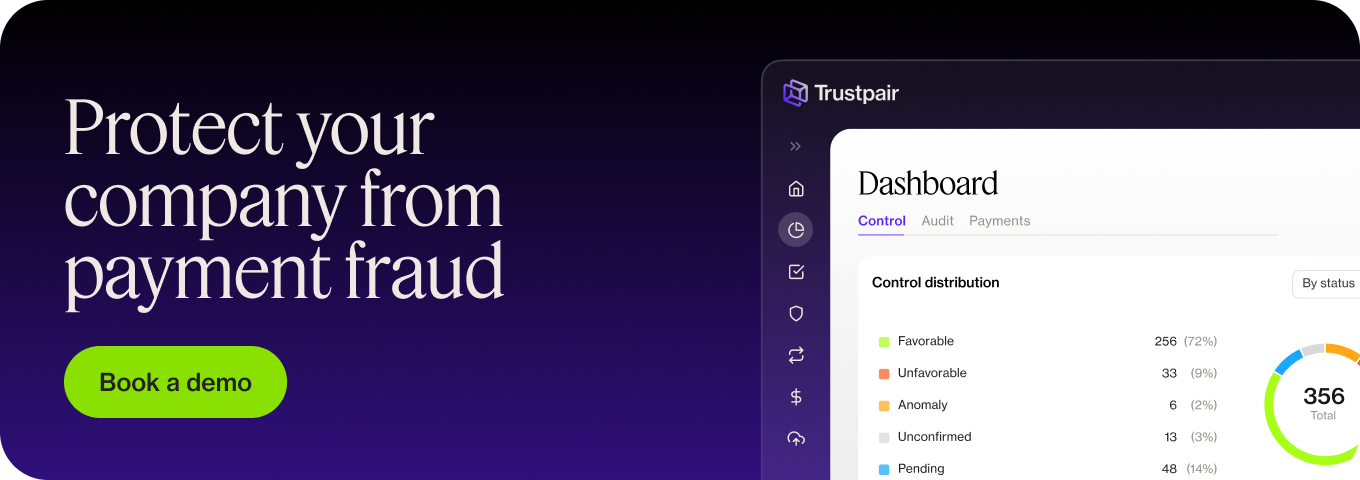In corporations, internal control can be defined as the processes and security measures set up to reach specific goals, ascertain legal compliance, and limit the risk of fraud.
It’s an essential component of every company’s organization. Those control measures can be a real defense against payment fraud attempts. They also guarantee the respect of internal ethical rules.
What do we speak of exactly when we mention internal control (or internal audit)?
What are the specific ways to set it up in your company?
How do internal control processes prevent and reduce the risk of corporate fraud?
Read on to get the answers to those questions! Do you want to learn more about corporate fraud risks and how to prevent them? Discover our report on B2B payment fraud and how to protect yourself from it
What is internal control?
As a general rule – and that’s even truer if you’re part of a large company – the internal audit department is the one in charge of internal control and reports to your financial department. Internal control aims to identify the potential risks linked to the non-compliance of your internal processes.
Let’s take an example. Companies often have a very specific way to manage their employees’ expense reports. If this process isn’t followed, or if there is a misstatement, it will eventually be spotted in your company’s general ledger. In turn, that has a negative impact on its solvency and legitimacy, especially in case of an external audit.
Today, there are heightened risks that come from online data processing and the general digitalization of work and processes. Therefore, internal auditing has had to adapt to control those risks and potential weaknesses, to be able to flag them and eradicate them.
More generally, we can define internal control as a safety system composed of means and resources adapted to your company whose goals are to:
- Make use of your company’s resources efficiently.
- Manage its activities to reach your global business objectives.
- Streamline all its operations and continuously improve its processes.
- Mitigate potential risks (financial, operational, compliance, or even security) and set up action plans in case they actually happen.
Who is involved in internal control?
The bigger your company is, the more complex your internal control processes get! Indeed, the more operations there are, the more internal control processes are needed. That also translates to more time spent evaluating those internal risks.
However, small businesses are also concerned by it – they mustn’t neglect internal control. Managing their financial risks will allow them to quickly master their activities and their associated risks. It’s better to start an internal control strategy from the beginning than when going through a quick growth phase.
What’s more, internal control involves all the company’s employees – not just executives. Even if you’re not part of upper management, you can ensure your internal processes are respected and flag any risks linked to your activities or your team. Nevertheless, it is up to management to define and monitor internal control processes depending on your company’s activities. That’s a part of their risk-management activities.
Since the Sarbanes-Oxley-Act (SOX) in 2002, internal control over financial reporting (ICFR) has been mandatory in the US. Enacted as a response to various corporate frauds and money laundering, it set up new compliance standards. In short, the Sarbanes Oxley Act aims to protect investors from corporate fraud. It applies to all publicly traded companies operating in the US as well as some private companies and covers both internal and external control.
The 5 key steps of internal control
Every corporation organizes its internal control however it thinks is best depending on its specificities (activity, organizational chart, management tools, etc.). However, there is a global methodology called the Coso framework which relies on the 5 following steps to guarantee efficient internal control:
1/ Organizing your internal control
For internal control processes to be efficient, they need to be tailored to the nature, size, and company’s specific activities. As we saw before, a company that’s quoted on the stock exchange won’t have the same internal control processes as a business employing 50 people.
What’s more, it’s important to analyze the resources and skills available in the corporation and use this frame of reference to clearly define everybody’s responsibility in each of the many processes. That analysis will allow for better risk management of each process.
This resource analysis as well as the use of a framework specific to each company will also enable the identification of the best-suited tools. In turn, that’ll allow you to set up the most relevant practices and processes. If we go back to our previous example of expense reports, you can choose dedicated software that’ll help you manage the inherent risks of your organization better by digitizing your processes.
2/ Efficiently communicating your internal control processes
An internal control system only works if it is well-known within your company. It’s not enough for management to know your internal control procedures. For internal control to be an efficient risk management tool, every employee needs to really appreciate its importance and usefulness.
Communicating your policies and procedures and their goal is, therefore, necessary for all employees to adhere to them. It’s also the first step of the actual operational implementation as it’ll allow each employee to understand the actions to take within their scope of work. It will limit the improper use of resources across your company.
This communication can take various forms: regular training on key topics, sending internal newsletters, etc.
3/ Carrying out risk assessments in your corporation
Depending on your team, departments, and the general organization within your company, different types will emerge from your risk assessment:
- Financial risks. They’re the risks linked to your company losing money. Contrary to popular opinion, this doesn’t only involve your accounting and finance departments. Other internal departments are concerned.
- Operational risks. Those risks can prevent your company from reaching its goals. If you’re an international business for instance and some of your activities take place abroad, it’s going to be more difficult to manage your entire production chain. Mapping your operational risks will be all the more complicated. It also involves operation work in fieldwork.
- Legal risks. Those risks have to do with your local, federal, and national laws. They can have a tremendous impact, especially in case of proven non-compliance, with fines amounting to several million dollars.
- Safety risks. Those risks relate to your information system, or even the physical safety of your employees if you are a labor-intensive company. In large corporations, cybersecurity risks and best practices linked to your data safety are today critical issues for management.
- Environmental risks. From non-respect of environmental regulations to using contaminating resources for your production, there are many risks that can threaten your company.
- Health risks. Those are linked to the good health of your employees or your consumers. They’re especially important if you’re an agribusiness for instance and must be carefully monitored from the very beginning of your activity.
4/ Implementing and controlling your processes
Once you have organized your internal control procedure and carried out your enterprise risk assessment, you need to actually implement your internal controls across your company. You, therefore, need to define the tasks and the scope for all your relevant employees.
For instance, it could make sense for the purchase manager of a heavy industry company to be in charge of monitoring environmental risks. Segregation of duties is key for an effective and efficient audit. It also helps combat fraud.
You then need to relay the information on internal risk management throughout your company – ensuring that the controls are in place, but also that they’re both relevant and efficient. It is indeed essential to regularly evaluate your internal control process itself.
5/ Staying up to date with your internal control.
Compliance with each process needs to be regularly checked to ensure that their goals are met and to stay relevant to your corporation’s processes. Processes now evolve quickly and your already established internal control rules can become obsolete fast.
The role of the internal control function
Within a company, the internal control body can be a person, a team, or even a whole audit committee. It all depends on the size of your company and its organizational chart. Here are the goals that your internal auditors help achieve:
- Protect and safeguard your company’s assets.
- Ensure your company’s compliance with applicable laws and regulations.
- Ensure top management’s directives are implemented to improve the company’s performance.
- Ensure the reliability of your financial statement and monitor all possible risks.
It’s an important and versatile role that has a real impact on the company’s efficacy.
Internal control is a proactive tool to block fraud attempts.
If you’re a publicly traded company, not setting up an internal control system makes you non-compliant and exposes you to legal repercussions.
More than that, not setting up internal control opens up the door for potential fraud. Without relevant processes, it’s indeed easy to take advantage of a breach, a human error, or any ill-managed risks.
Without well-established internal auditing standards, fraud attempts (especially IT frauds) can be detected too late. That could lead to grave consequences for companies – beyond even the subject of corporate governance.
It’s especially the case nowadays, with international companies having a production chain spread out in different countries and using fully digitized data systems. Securing your data and activities proves to be more complicated, which makes your internal control processes even more important.
If internal control is necessary, it is nevertheless not enough to guarantee fail-proof risk management. It’s only one of the components of your company’s security strategy and cannot be your only protection against risks. It’s even truer as fraudsters become more and more inventive with their fraud attempt.
Using an automated solution like Trustpair to reduce – and even eradicate – your risk of financial fraud is necessary to complement your internal control processes. Our platform makes your entire payment chain secure, eliminating the risks of bank transfer fraud thanks to systematic control of third-party information. (Learn more about third-party risk management in this article.)
Are you interested? Ask for a demo!
Key Takeaways:
Internal control can be defined as the processes and security measures set up to reach specific goals, ascertain legal compliance, and limit the risk of fraud. Because internal control highlights your weaknesses, it helps you improve both risk assessment and risk-management in your company. For publicly traded companies, internal control over financial reporting is mandatory in the US following the Sarbanes-Oxley Act of 2002.
Your internal control body can be a whole department or an internal controller. It’s up to management to determine the scope of it and who the key people and actions are. It’s also a shared duty across the company. Every employee must be aware of the internal processes to follow to ensure global compliance.
The 5 steps of internal control are as follows:
1. Organizing your internal control
2. Efficiently communicating your internal control processes
3. Carrying out risk assessments in your corporation
4. Implementing and controlling your processes
5. Staying up-to-date with your internal control
Internal control is a necessary tool for compliance but beyond that, it is a crucial component to protect your company against fraudsters.
Another element of an efficient strategy against fraud attempts is using software like Trustpair. Our solution helps you eradicate the risks of fraud with third parties.






